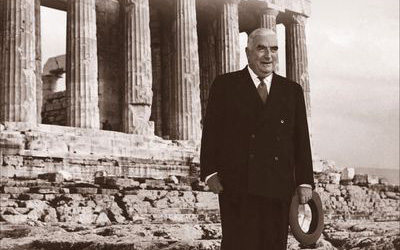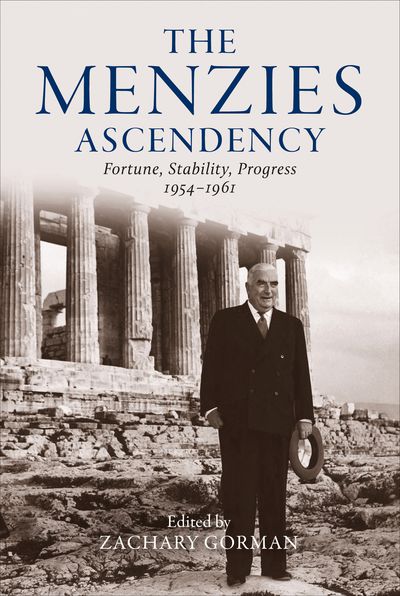
- Free Article: No
- Contents Category: Politics
- Review Article: Yes
- Article Title: Constructive tensions
- Article Subtitle: New perspectives on the Liberal founder
- Online Only: No
- Custom Highlight Text:
Australian liberals and the Liberal Party were once thought laggards in attending to their own history in comparison with the Labor Party. Even so, Robert Menzies’ life and career had been well documented, with multiple biographies and memoirs, including Allan Martin’s masterful two-volume biography (1993-99) and Judith Brett’s influential analysis of Menzies’ ‘Forgotten People’ speech as a key to understanding the ‘public life’ (1992). More recently, liberal political history has become a cottage industry.
- Featured Image (400px * 250px):

- Alt Tag (Featured Image): James Walter reviews ‘The Menzies Ascendency: Fortune, stability, progress 1954-1961’ edited by Zachary Gorman
- Book 1 Title: The Menzies Ascendency
- Book 1 Subtitle: Fortune, stability, progress 1954-1961
- Book 1 Biblio: Melbourne University Press, $50 hb, 318 pp
- Book 1 Cover Small (400 x 600):

- Book 1 Cover (800 x 1200):

- Book 1 Readings Link: https://www.readings.com.au/product/9780522881066/the-menzies-ascendency--zachary-gorman--2024--9780522881066#rac:jokjjzr6ly9m
Yet, the rewriting of liberalism from a contemporary perspective – John Howard’s The Menzies Era (2014), Troy Bramston’s Menzies biography (2019), David Kemp’s five-volume history of Australian liberalism (2018-22) – offers a revisionist history of Menzies, and of liberalism. It downplays the tradition of commitment to individual freedom allied with an expectation of state support for those who cannot help themselves, critically analysed in Keith Hancock’s Australia (1930). Now, a more explicitly individualistic, enterprise-oriented liberalism is favoured.
The Robert Menzies Institute, housed at the University of Melbourne, charged to honour Menzies and promote knowledge of his legacy, has made a significant contribution to this enterprise, hosting a series of conferences, each of which has resulted in a book. This volume is the third of these: a slice history of one phase of Menzies’ administration – 1954 to 1961 – deemed the consolidation of his ascendancy (MUP, please note the correct spelling!).
To their credit, Institute director Georgina Downer and editor of the book series, Zachary Gorman, have consistently drawn in not only committed liberals, academics and party figures, but also others – such as Frank Bongiorno, Judith Brett, and, in this volume, Paul Strangio – not identified with that cohort. Implicitly, this sustains debate over what Isaiah Berlin famously called ‘the two faces’ of liberalism.
Inevitably, there are constructive tensions. Some of those contributing to this series ignore Brett’s reminder in the first volume of Menzies’ debt to Deakinite liberalism and faith in an enabling state. They promote the current more individualistic liberalism. This book opens with a zinger: Anne Henderson, fierce advocate of the liberal right, and Strangio, historian of the Victorian Labor Party, each dealing with what is commonly thought Menzies’ greatest boon, the Labor Party Split of 1955.
For Henderson, the Split was entirely about leadership – a clash of individuals: Evatt’s ineptitude and psychological oddity against Menzies’ skilful recognition of dangers to be addressed; and his capacity to bait Evatt, capitalising on his weaknesses – in short, Menzies as ringmaster of the Split. Strangio, in contrast, counters the ‘great man’ theory of history and of Menzies’ agency. He tells a story of institutional failure: the chronic weakness and underperformance of the Victorian Labor Party at that time, making it the epicentre of the ALP Split. Using voting figures and historical records, Strangio argues that the Split was ‘fundamentally a Victorian phenomenon’, with the bastard child of the failed Victorian political project, the Democratic Labor Party, gifting federal and state elections to the Coalition from 1955 to the 1970s, rendering Menzies impregnable.
The challenge to balance the personal and the contextual hangs over subsequent chapters. Most, understandably, seek to capture why Menzies was such a towering figure in each domain discussed. Selwyn Cornish meets the challenge aptly in his impressive chapter on the creation of the Reserve Bank, as do Andrew Norton, discussing higher education, and Sean Jacobs on Indonesia and the West New Guinea dispute (1950-62). Each of them asks: what might have been different, and how, if Menzies had not been there? Their answers shed new light on Menzies’ capacity to accept innovation and willingness, when he saw national interests at stake, to stand up to the contrary urgings of Coalition insiders and ‘great and powerful’ friends.
Others handle it less convincingly. Lyndon Megarrity’s revisiting of Queensland’s contribution to Menzies’ ‘close shave’ in the 1961 election tells us much about that state’s persisting perception of ‘neglect’. But Strangio counters Megarrity’s contention that Queensland determined the election in the first pages of his exposition of Victorian exceptionalism.
David Lee charts the establishment of a unified department of trade, the abolition of import controls, a Commerce Agreement with Japan and the opening of wheat trade with China under Menzies as indicative of the origins of the open economy and prosperity usually attributed to the enterprise of Bob Hawke, Paul Keating, and Howard. Yet one cannot help being reminded of Ian McLean’s superb Why Australia Prospered (2013). He warns against overestimating the significance of domestic politics as against the global currents that supported the postwar ‘golden age’. McLean analyses Australia’s fortunes as indicative of an international phenomenon – the emergence of a stable, well-functioning international economic system. Menzies and his colleagues do not appear in this discussion, even in the index.
Then there is the Suez Crisis of 1956. It is often thought to be Menzies’ greatest international blunder. He agreed to act as agent for Anthony Eden and Dwight Eisenhower in negotiations with Egyptian President Nasser in Cairo. Having failed, he attempted to sustain Eden’s wishes while conciliating the furious disagreement between Britain and the United States over the Anglo-French seizure of the canal following its nationalisation by Nasser. Robert Bowker here exposes Australian attitudes towards the United States through the correspondence and reports of key actors. Menzies’ ideological blinkers are confirmed, but Australia might have fared worse without the fine diplomacy of Richard Casey and James Plimsoll.
No one has yet accurately captured the cultural impact of the Suez Crisis in regenerating support for the ALP, especially among those who later flocked to Whitlam’s cause. Graham Freudenberg’s engaging memoir, A Figure of Speech (2005), calls this out. For Freudenberg, a child before the war, politically aware by the time his parents responded to Menzies’ call to ‘the forgotten people’, and working in England during the Suez crisis, this ‘profoundly immoral’ intervention was his ‘road to Damascus’, prompting him to return home, shift from right to left and join the ALP. There he became a foundational figure in the creative rearticulation of the Labor cause. For Freudenberg, and other children of the ‘forgotten people’, Suez disrupted the ethical contract supposedly binding ‘the moral middle class’ to the Liberal Party.
That said, it is helpful to have new and stimulating contributions in areas less well studied, such as Elizabeth Buchanan’s careful elaboration of Menzies’ and Casey’s success in negotiating the Antarctic Treaty. Michael de Percy’s chapter on Australia in the Atomic Age will be red meat to current liberals. The contemporary Liberal Party must be reminded of its earlier progressive history: see David Furse-Roberts’s chapter on old age and health reform, Paul Brown’s chapter on the relaxation of immigration restrictions (surprisingly, with conservative Alick Downer stepping up to defend Calwell’s intentions when Labor regressed), Damien Freeman’s and Andrew Bragg’s chapter on Hasluck, Wentworth, and Indigenous policy, and Ted Ling’s chapter on federal support for the development of Canberra. All these contributions bear witness to Menzies’ continuing commitment to an enabling state; each of them poses challenges for current Liberal policies on just these issues.
Whatever one’s reservations, this book demolishes Donald Horne’s and Paul Keating’s canard that little of significance was done under Menzies. There were moments of theatre – the attempt to ban the Communist Party, the ALP Split, the Suez Crisis. But, as Paul Kelly argues in an appendix, the wide spread of policy and policy initiative revealed here, and in preceding volumes, shows that Menzies’ gift was to preside over consequential decisions and incremental change while avoiding the appearance that anything dramatic was happening. Would that later prime ministers had this capacity!


Comments powered by CComment